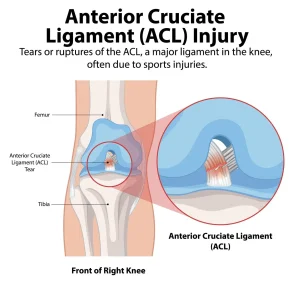Overview
Diagnosis
Diagnosis typically begins with a physical examination of the knee:
-
The healthcare provider checks for swelling, tenderness, and instability.
-
The injured knee is compared to the uninjured knee to assess differences in function and range of motion.
-
Specific movements may be tested to evaluate ligament integrity and joint stability.
Imaging Studies
Although a clinical exam often suffices, imaging may be necessary to confirm the diagnosis and assess the severity of the injury:
-
X-rays:
Used to rule out fractures. X-rays do not visualize ligaments, tendons, or cartilage. -
Magnetic Resonance Imaging (MRI):
MRI provides detailed images of both soft tissues and bone, allowing evaluation of the ACL, meniscus, cartilage, and surrounding ligaments. -
Ultrasound:
May be used to assess damage to ligaments, tendons, and muscles around the knee.
Treatment of ACL Injury
Immediate Care
After an ACL injury, prompt first-aid care helps reduce pain and swelling. The R.I.C.E. method is commonly recommended:
-
Rest: Limit weight-bearing and activity to prevent further injury.
-
Ice: Apply ice packs to the knee every 2 hours for 20 minutes when awake.
-
Compression: Use an elastic bandage or compression wrap.
-
Elevation: Keep the knee raised on pillows to minimize swelling.
Rehabilitation
-
Initial treatment usually involves physical therapy to restore range of motion, strength, and stability.
-
Braces and crutches may be used to stabilize the knee and reduce stress on the joint.
-
Rehabilitation exercises are tailored to the patient’s activity level and may include at-home routines or supervised therapy sessions.
-
Non-surgical management may be sufficient for less active individuals or those involved in low-impact activities.
Surgical Treatment
Surgery may be recommended for:
-
Athletes wishing to return to sports that involve pivoting, jumping, or cutting movements.
-
Injuries involving multiple ligaments or cartilage damage.
-
Knees that give way during everyday activities.
ACL Reconstruction:
-
The torn ligament is replaced with a graft, which may be taken from the patient’s own tendon (autograft) or from a donor (allograft).
-
Surgery restores stability and allows proper knee mechanics.
Post-Surgery Rehabilitation:
-
Extensive physical therapy follows surgery to regain strength, range of motion, and coordination.
-
Athletes may require up to a year or more to safely return to competitive sports.
-
Functional testing by healthcare professionals evaluates knee stability, strength, and readiness before resuming high-risk activities.
-
Early return to sports may increase the risk of re-injury; recent studies show up to one-third of athletes experience a second tear within two years.
Long-Term Considerations
-
Adequate rehabilitation and strengthening programs are essential for reducing re-injury risk.
-
Patients should focus on optimizing movement patterns, balance, and joint stability before returning to high-intensity or pivoting sports.
-
Ongoing monitoring by a physician or physical therapist ensures proper recovery and supports safe participation in athletic activities.
Advertisement

